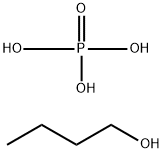General Description
A colorless liquid. Insoluble in water. Density about 9.4 lb / gal. Corrosive to metals and tissues. Flash point of 230°F.
Air & Water Reactions
Insoluble in water.
Reactivity Profile
Organophosphates are susceptible to formation of highly toxic and flammable phosphine gas in the presence of strong reducing agents such as hydrides. Partial oxidation by oxidizing agents may result in the release of toxic phosphorus oxides.
Health Hazard
TOXIC; inhalation, ingestion or skin contact with material may cause severe injury or death. Contact with molten substance may cause severe burns to skin and eyes. Avoid any skin contact. Effects of contact or inhalation may be delayed. Fire may produce irritating, corrosive and/or toxic gases. Runoff from fire control or dilution water may be corrosive and/or toxic and cause pollution.
Fire Hazard
Combustible material: may burn but does not ignite readily. When heated, vapors may form explosive mixtures with air: indoors, outdoors and sewers explosion hazards. Contact with metals may evolve flammable hydrogen gas. Containers may explode when heated. Runoff may pollute waterways. Substance may be transported in a molten form.
Hazard
Strong irritant to skin and tissue.
Potential Exposure
Butyl acid phosphate is a clear white liquid.
Molecular weight 5 153.08; Flash point 5 110�C. Hazard
identification (based on NFP A-704M Rating System):
Health 2; flammability 1; reactivity 1 ?. Insoluble in water.
Potential Exposure: It is used in industrial chemicals
manufacture
First aid
If this chemical gets into the eyes, remove any
contact lenses at once and irrigate immediately for at least
15 minutes, occasionally lifting upper and lower lids. Seek
medical attention immediately. If this chemical contacts the
skin, remove contaminated clothing and wash immediately
with soap and water. Seek medical attention immediately.
If this chemical has been inhaled, remove from exposure,
begin rescue breathing (using universal precautions, including resuscitation mask) if breathing has stopped and CPR if
heart action has stopped. Transfer promptly to a medical
facility. When this chemical has been swallowed, get medical attention. If victim is conscious, administer water or
milk. Do not induce vomiting. If pulmonary edema develops from high exposure, medical observation is recommended for 24 to 48 hours
Shipping
UN1718 Butyl acid phosphate, Hazard class: 8;
Labels: 8—Corrosive material. UN326 Corrosive liquid,
acidic, organic, n.o.s.; Hazard class: 8; Labels: 8—
Corrosive material, technical name required
Incompatibilities
Organophosphates are susceptible to formation of highly toxic and flammable phosphine gas in the
presence of strong reducing agents such as hydrideds and
active metals. Partial oxidation by oxidizing agents may
result in the release of toxic phosphorus oxides
Incompatible with oxidizers (chlorates, nitrates, peroxides,
permanganates, perchlorates, chlorine, bromine, fluorine,
etc.); contact may cause fires or explosions. Keep away
from alkaline materials, strong bases, strong acids, oxoacids, epoxides
Description
Butyl acid phosphate is a clear white liquid.Molecular weight=153.08; Flash point=110 ℃. HazardIdentification (based on NFPA-704 M Rating System):Health 2, Flammability 1, Reactivity 1. Insoluble in water.Potential Exposure: It is used in industrial chemicalsmanufacture.
Chemical Properties
Water-white liquid.Soluble in alcohol, acetone, and toluene;
insoluble in water and petroleum naphtha. Com-
bustible.
Flammability and Explosibility
Nonflammable
storage
Color Code—White: Corrosive or Contact Hazard;Store separately in a corrosion-resistant location. Store intightly closed containers is a cool, well-ventilated areaaway from potentially high-heat sources.
